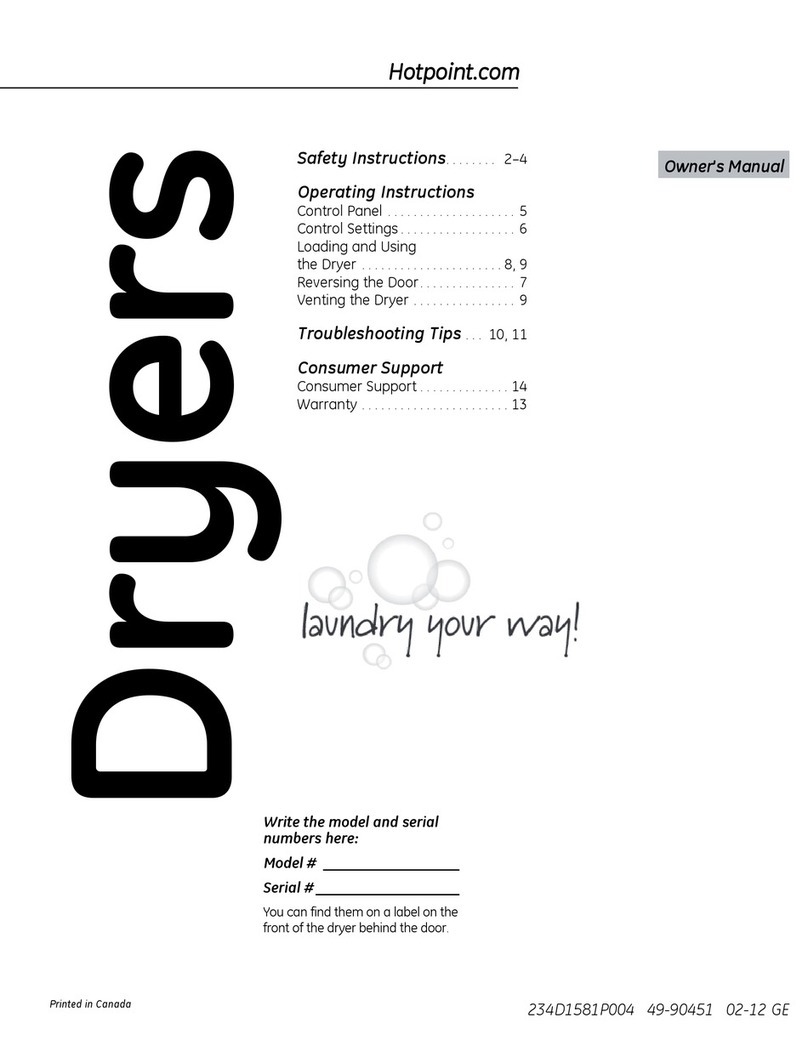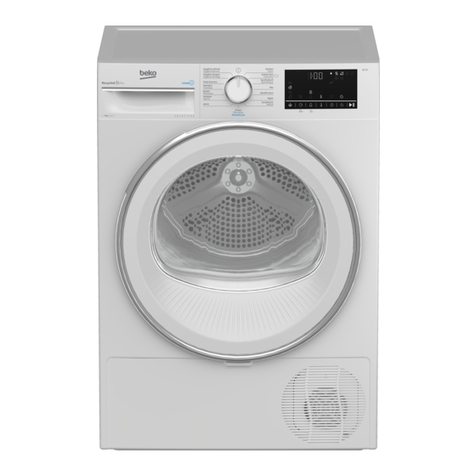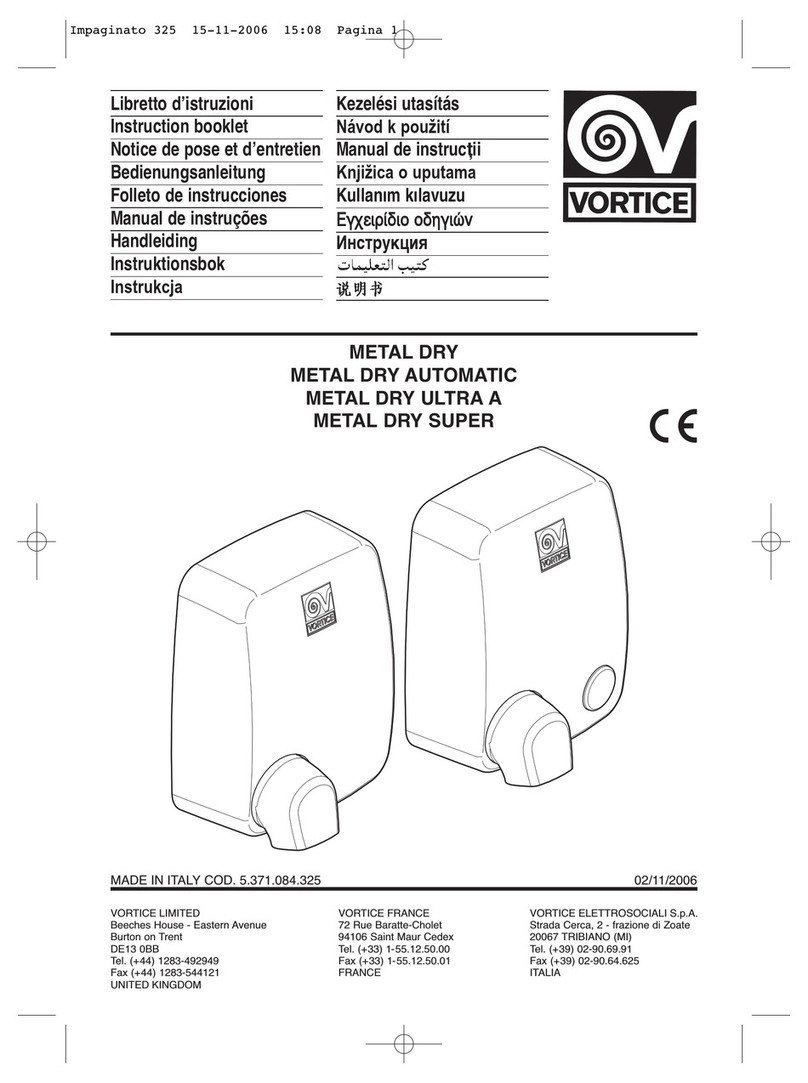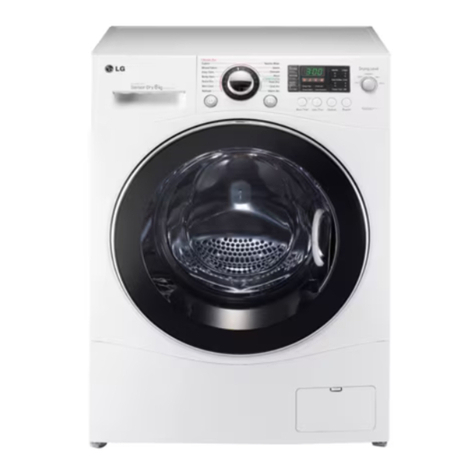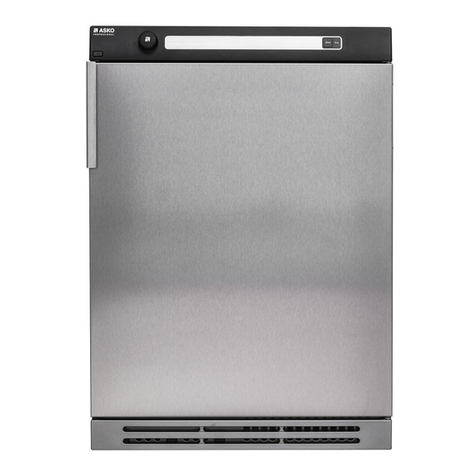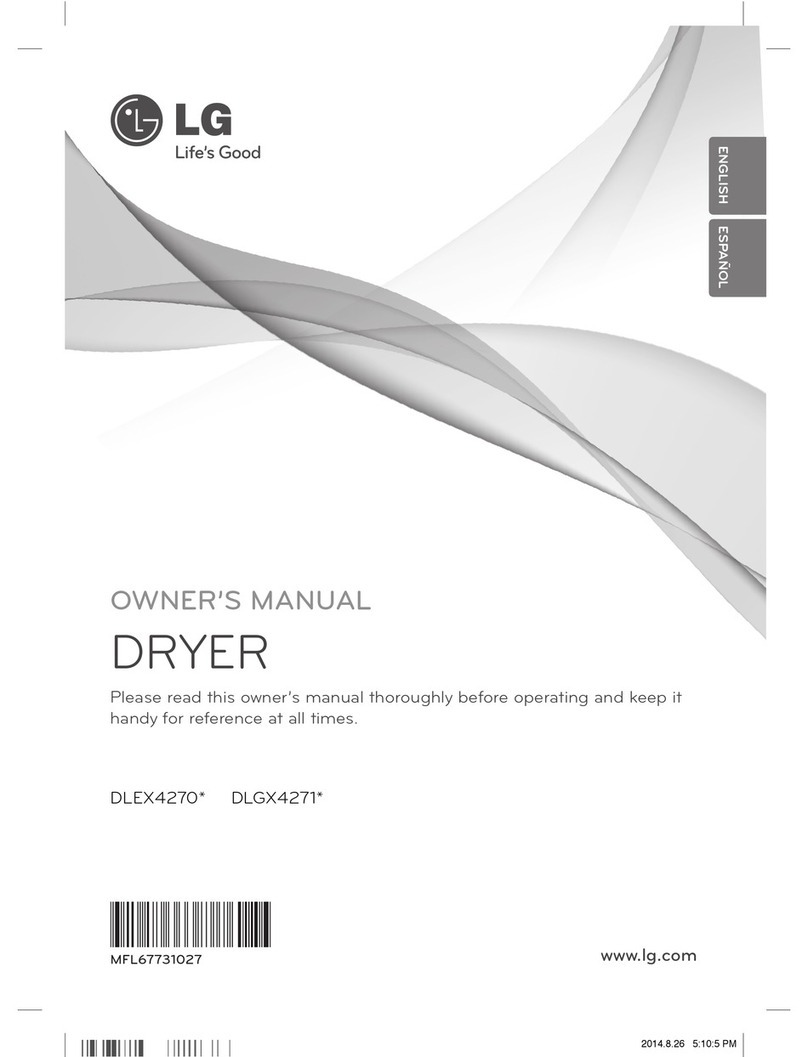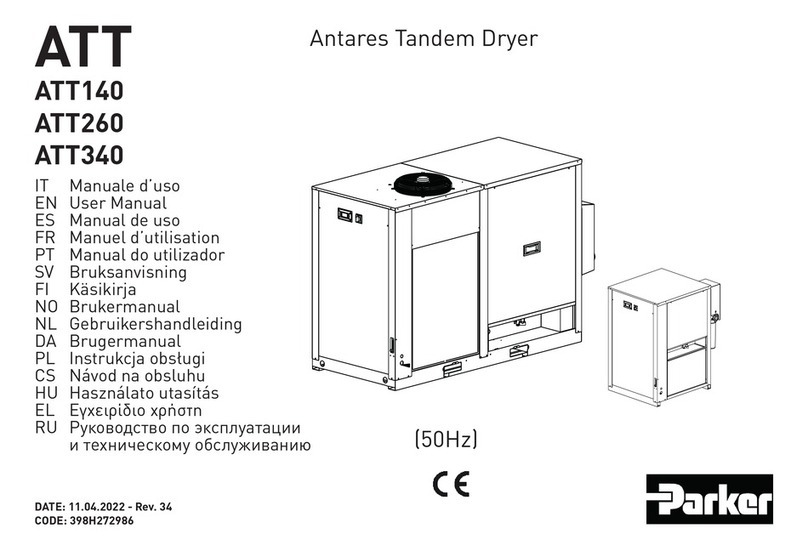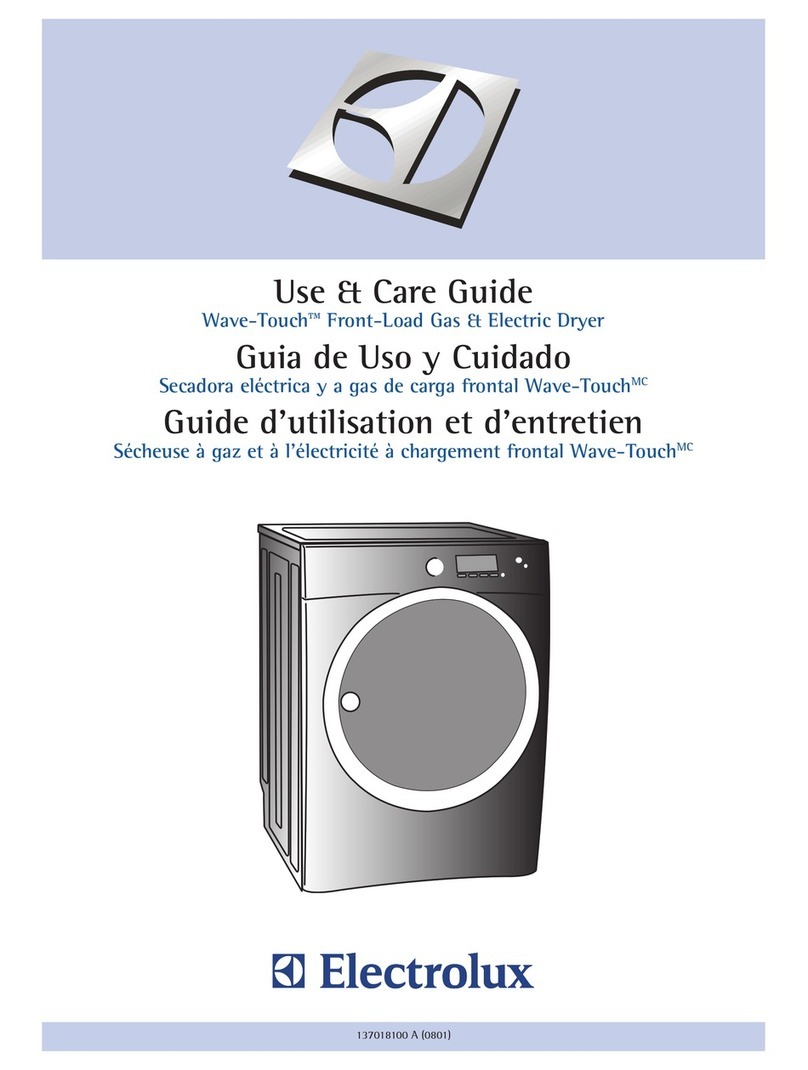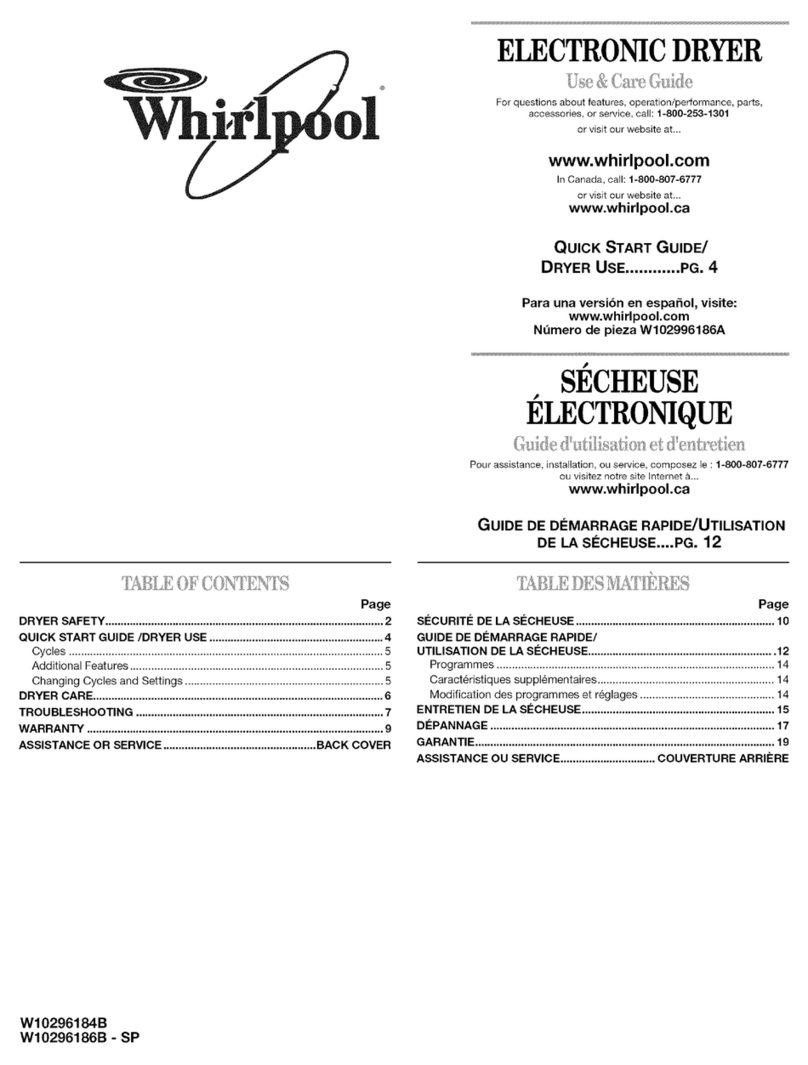FERREX Eco Dryer User manual

MAINTENANCE MANUAL
FOR
4.5x45 Eco Dryer
Draft
Prepared by:
FERREX ENGINEERING LTD. REF. #2278
230 Westney Rd.
Ajax, Ontario, Canada L1S 7J5 Jun 2016

MAINTENANCE MANUAL – ELECTRIC ROTARY DRYER
FERREX ENGINEERING LTD. Page 2 Ref. #2278
CONTENTS
1. Safety/ LOTO Procedures page 3
2. Equipment Description page 4
3. Assembly /Set-Up page 5
4. Operation page 13
5. Maintenance page 14
6. Spare Parts page 19
7. Drawings page 20

MAINTENANCE MANUAL – ELECTRIC ROTARY DRYER
FERREX ENGINEERING LTD. Page 3 Ref. #2278
1. SAFETY / LOTO PROCEDURES
Ensure operators are wearing appropriate PPE while operating the equipment.
The following lists the procedure for locking out and tagging out the dryer.
1. On the HMI Ensure the primary and secondary heaters are turned off by turning the heater
selector switch to the off position.
2. On the HMI Turn off the fan (if not already done so) by depressing the fan stop Push Button.
3. On the HMITurn off the drum rotation (if not already done so) by depressing the drum stop
Push Button.
4. Primary and Secondary cabinet main power disconnect to the powered off position. Place
locks and tags on the disconnect handle / bracket.
5. Check that power is turned off by testing the fan and the drum rotate by depressing the drum
start and the fan start push buttons on the HMI. The fan and drum should not start rotating.
6. The drum will have stored heat for some time after the heater is turned off. There are no
stored energy devices in the dryer system.

MAINTENANCE MANUAL – ELECTRIC ROTARY DRYER
FERREX ENGINEERING LTD. Page 4 Ref. #2278
2. EQUIPMENT DESCRIPTION
The electrical dryer has been designed to operate outside or in a building above 40 deg. F. It is
designed to remove upto 10% of starting weight of moisture of 20,000 lbs hour material. A
moisture sensor located at the discharge will monitor the moisture content of the material leaving
the dryer and will adjust the amount of heat as required to maintain the desired discharge material
moisture levels.
Primary heater consists of 700KW heater unit with a 3,000 to 6,000 cfm fan that injects hot clean
air between temperatures of 200 f upto 700 f into the electric dryer.
Secondary heater consists of 150 kw heater unit with a 600 cfm fan that injects hot clean air
between 200 f upto 700 f into the electric dryer’s byproduct ducting to keep the air from not
concendating.
Baghouse is sized to capture all the byproduct material and have the moisture exist to
atmosphere.

MAINTENANCE MANUAL – ELECTRIC ROTARY DRYER
FERREX ENGINEERING LTD. Page 5 Ref. #2278
3. ASSEMBLY / SET-UP
The dryer drum assembly was assembled and dry tested at the fabricating shop prior to shipping.
The dryer drum assembly will be shipped assembled. The remaining air inlet assembly and the
air discharge assembly will be broken down with flanged bolted connections required to comply
with shipping regulations. The bearings will be lubricated at assembly. When the unit arrives, it
should be carefully inspected to make sure that the unit is in good condition and that all of the
components listed on the packing slip are received. Loose items are typically packed in boxes on
a skid.
The field flanged assembled duct / pipe components will require dust tight sealed connections.
Use high temperature joint strip gasket material with joint sealing compound to the housing
flanges. When possible, gasketing should be done on the ground before hoisting the piece into
place. Duct / pipe sections after the primary and secondary tube heaters are to be insulated. The
insulation and the insulation metal coverings including the duct elbows will be supplied and
installed during installation. The pipe insulation comes in split preformed sections for easy
installation including the tape to seal the insulation joint. The rolled metal insulation cover is to be
cut and strapped to the outside of the insulation. Suitable caulking to seal the metal cladding and
boots for the ends are supplied.
1. The dryer drum assembly will require a spreader beam and straps to be crane lifted off
the shipping truck and again during installation. Crane should be rate 20 tons capacity.
2. Using a spreader beam and straps lift and mount the dryer drum assembly on to the drum
support frame (drum support frame by installer). Using shims, level the dryer drum and
bolt (bolts by installer) the drum to the support frame at six column locations. The dryer
drum is to be at an 1.25 degree angle of incline.
3. Mount the vibrating inlet feeder on to the feeder support frame (feeder support frame by
installer). The feeder discharge tube is to be aligned with the inlet hole on the face of the
drum inlet hood. Using shims as required, bolt the vibrating feeder to the support frame.

MAINTENANCE MANUAL – ELECTRIC ROTARY DRYER
FERREX ENGINEERING LTD. Page 6 Ref. #2278
Install the expansion joint between the vibrating inlet feeder and the drum inlet hood using
the clamps provided.
4. Fill the gearbox with oil to the oil fill level mark on the dip stick.
5. The air inlet assembly as shown on drawing 2243-4545-MC-123 will arrive in pieces to be
bolted together. The fan and the primary tube heater support frame would be anchored
(anchors by installer) to the building concrete floor after final assembly. Mount and bolt
the primary tube heater onto the tube heater support frame supplied. The un-insulated
tube heater inlet pipe will have the flanges tack welded only, for testing of the set-up,
which will allow a small amount of field adjustment, if required. Break the tack welds and
retack the flanges to the pipe if necessary to align bolts and ensure the pipe flanges are
flush. Use the garlock seals supplied for the 150# raised face flange connections to the
tube heater. After any field adjustments are completed then field weld the pipe flanges to
the pipe and bolt the inlet pipe to the fan and the primary tube heater. The primary tube
heater insulated discharge pipe would be bolted the drum inlet hood and the tube heater
discharge as shown. The flange connection to the primary tube heater would only be tack
welded to allow for a small amount of field adjustment as required. It may be required to
shim / move the tube heater and support frame if a large amount of adjustment is
required. The tube discharge pipe has an expansion joint located just after the
connection to the drum inlet hood. The discharge hood is supported with a bracket off the
inlet hood. Using the two bolts supplied, finger tightten (with jam nuts) the two bolts so
that the discharge pipe can float laterally relative to the expansion joint. After field
adjustment is complete, weld the 150# raised face flange to the discharge pipe and bolt to
the tube heater to the discharge pipe with the bolts supplied. Use the garlock seals
supplied for the 150# raised face flange connections to the tube heater. Use the small
container of paint supplied to repair paint and clean up any weld splatter. Install the pipe
insulation and insulation cladding.
6. The air discharge assembly as shown on drawing 2243-4545-MC-124 will arrive in pieces
to be bolted together. The secondary tube heater support frame is to be bolted to the
dryer drum frame as shown. The secondary heater fan support stool is then bolted to the
secondary tube heater support frame. On the opposite side of the drum, two brackets are

MAINTENANCE MANUAL – ELECTRIC ROTARY DRYER
FERREX ENGINEERING LTD. Page 7 Ref. #2278
to be bolted to the side of the dryer drum frame as shown used to support the insulated
baghouse inlet pipe. Mount and bolt the the secondary tube heater onto the support
frame. Mount and bolt the secondary fan to the fan support stool. Mount and bolt the
secondary tube heater inlet pipe between the fan and the secondary tube heater. Use the
garlock seals supplied for the 150# raised face flange connections to the tube heater.
The secondary tube heater insulated discharge pipe would be bolted at the top to the
insulated baghouse inlet pipe. At the top of the drum discharge hood the discharge
damper is to be bolted to the top of the drum discharge as shown. Bolt the insulated
discharge pipe to the secondary tube heater. Use the garlock seals supplied for the 150#
raised face flange connections to the tube heater. Use U-bolts to secure the insulated
baghouse inlet duct to the support brackets. Use the small container of paint supplied to
repair paint and clean up any weld splatter. Install the pipe insulation and insulation
cladding.
Seals Assembly
FabriSealtm- shown with
relief slits cut. Holes are
punched at installation.
Mounting ring tack welds
directly to hood.
Retaining ring
Seal assembly comes complete with the FabriSealtm, tension strapping and springs, and
strap length adjustment clips.

MAINTENANCE MANUAL – ELECTRIC ROTARY DRYER
FERREX ENGINEERING LTD. Page 8 Ref. #2278
Needed Tools:
1) Sockets and wrenches to fit nuts and bolts of mounting
assembly.
2) Sharp knife to cut bolt hole slits into seal.
FabriSealtm Installation:
1) Remove the old seal and replace any old bolts that are damaged.
2) Run a belt sander or grinder over the shell surface around the sealing area to remove any rust,
weld spatter, beads, or product buildup. If the shell walks longitudinally during operation, sand
the area also where the seal will ride. Polish the shell as much as possible as this will greatly
extend the effective life of the seal.
3) Lace the yellow tension straps through the belt loops. The straps should be laced in from the
ends of the seal to meet in the middle. There will be one segment for shell diameters up to 4’,
two segments for 4’-8’ diameters, and three segments for shells over 8’ OD.
4) Sling the seal over the shell such that the seal hangs evenly. This will allow the seal to overlap at
the exact bottom of the shell to facilitate possible feed dump cleanout.
5) Starting at the top, position the seal such that it forms a 90-degree angle with the shell (see
sketch pg. 3). The seal contact area should be about 2 ½” to 3”. Make sure there is not severe
seal sag between the ring and the shell (This will cause the seal to wander on the shell and
possibly invert back into the hood). Use a sharp knife and cut slits in from the outside edge of the
seal making sure to only cut deep enough to fit over the bolt holes. This will “relax” the seal on
the mounting ring as well as relieve the “pucker” on the shell surface.
6) Work your way down the sides fairly evenly cutting bolt hole slits. As sufficient bolt hole slits are
made, clamp the seal in place with the clamping ring segments.
7) When the bottom is reached, make sure the overlap corresponds with the direction of rotation
(see sketch pg. 3). If installed backwards, the seal will roll up and fail.
8) Lace the strap ends into the length adjustment clips. Affix the tension springs to the clips. Do not
attach the springs to anything other than the strapping clips and vice versa. Do not hang weights
from the springs or strapping. You can adjust the strapping length as needed.
9) Check the sag at the bottom of the seal. A slight gap (1/4” to ½”) is desirable at the bottom. This
will allow for thermal expansion of the shell when heated.
The last step is important such that testing is highly recommended prior to
operation.
10) Rotate the shell while pulling operating draft (if possible) to test the seal fit prior to firing and
operation. Observe the fit around the sealing surface. Adjust the fit accordingly remembering to
allow for thermal shell expansion. The seal only needs to make light continuous contact with the

MAINTENANCE MANUAL – ELECTRIC ROTARY DRYER
FERREX ENGINEERING LTD. Page 9 Ref. #2278
shell to be an effective seal. Cranking it down tight to the shell does NOT enhance the sealing
properties of the FabriSeal. All this will do is cause the seal to wear much faster.
Overlap seal as shown to
avoid binding. This
should be done at 6
O’clock to aid in
cleaning out possible
feed dump.
Proper Configuration
Improper
Configuration
Seal contact area.

MAINTENANCE MANUAL – ELECTRIC ROTARY DRYER
FERREX ENGINEERING LTD. Page 10 Ref. #2278
BAGHOUSE ASSEMBLY / INSTALLATION
1. Foundation loads and structural orientation as per drawing 2243-4545-MC-127.
Foundations to be designed by installer. Place structural legs on foundation pads. Bolt
the lower bracing clips to the legs using the angle clips. Bolt the top structural channels to
the legs making sure the support is free standing. Anchor (anchors by installer) and grout
the baghouse support structure to the foundations.
2. See drawing 2243-4545-MC-127 for orientation of the lower hopper. Apply joint sealing
compound to all flanges and joints in the assembly of the hopper. Lift the gasketed
hopper into the correct position sitting on top of the support channels. After the bottom
hopper are in place and the flange gaskets are applied, the top dust collector assembly
may be picked up by the lifting lugs. Lift the dust collector into place and set it on the
structural support and the hopper. Bolt the bottom flange of the dust collector to the
hopper and the support channels. Position holes with drift pins as required.
3. Install all walkways and ladders per the general arrangement drawing. If possible, install
the walkways and ladders to the dust collector before lifting the dust collector into place.
4. Apply gasket and sealant to the top flange of the rotary valve and bolt the rotary valve to
the flange at bottom of the hopper.
5. Connect clean dry 80-100 psig compressed air (dew point less than -20 F) to the air
coupling at the air pipe manifold. A filter, pressure regulator should be installed in the
supply line to “fine-tune” the air cleaning system.
ELECTRICAL INSTALLATION
The electrical dryer will come complete with two electrical enclosures, which will be installed
behind the main MCC room. One Panel will be labled Main Dryer Panel and one labled Baghouse
Heater Panel.
MAIN DRYER PANEL

MAINTENANCE MANUAL – ELECTRIC ROTARY DRYER
FERREX ENGINEERING LTD. Page 11 Ref. #2278
The main dryer panel will require a 1200amp 480V 3phase 60hz supply to the main disconnect.
Refer to drawing 2270-300-E-001.
1. The main heater on the dryer itself requires 6X117KW feeds from the main dryer panel.
Please refer to the single line diagram 2270-300-E-001.
2. The tube vibrator feeder requires a main power feed refer to 2270-300-E-001
3. Run a separate 120V 15 Amp feed to Fuse 10 in the panel for the main control circuits.
See drawing 2270-300-E-001, 2270-300-E-310.
4. The main motor for the drum rotation is to be connected to the VFD labled Drive Motor.
The rotation for this motor must have the drive chain in tension at the top of the drum at
all times.
5. The fan motor for the main inlet air must be connected to the VFD labled Fan Motor.
Please refer to the rotation arrows on the fan and motor for proper rotation.
6. Field install the Stack Light system close to the dryer. This will allow the system to warn
the users that the unit is starting up or has a fault.
7. Install the level sensor on the bracket. Ferrex Engineering will calibrate the level sensor
at startup.
8. Install the supplied Thermal Couples (TS3, TS8, (TS5 Moisture sensor)) and wire them
back to the PLC cards as per the electrical drawing package included in the specification
TS1,2, are on the main heater. Refer to drawing 2243-400-P-001
9. Wire the analog singal cable from the moisture sensor back to the dryer panel PLC as per
the electrical drawing package.
10. Refer to 2270-300-E-330 for N.F System ESTOP integration to the dryer panel.
11. The dryer panel will require an Ethernet communication from the business network (the
main internet source). Please follow the network diagram provided in the drawing
package.

MAINTENANCE MANUAL – ELECTRIC ROTARY DRYER
FERREX ENGINEERING LTD. Page 12 Ref. #2278
BAGHOUSE SECONDARY HEATER PANEL
1. Install the Panel agecent to the main dryer electrical panel.
2. Follow Drawing 2270-300-E-002 to run the main 400 Amp 480V 3phase 60Hz power
supply to the panel.
3. Wire the two 75kw heaters to the main panel as shown on drawing 2270-300-E-002
4. Wire the clean side fan, rotary valve for the baghouse, and secondary heater fan as per
drawing 2270-300-E-002.
5. Wire baghouse cleaning valves, and baghouse enclosure heater 120V circuits as per
drawing 2270-300-E-310 and 2270-300-E-341.

MAINTENANCE MANUAL – ELECTRIC ROTARY DRYER
FERREX ENGINEERING LTD. Page 13 Ref. #2278
4. OPERATION
The electric dryer comes with controls that the operator can run in automatic or manual.
If the operator selects automatic (Dynamic Dry) he/she is asked to dial in the output moisture
target level. Dynamic Dryer takes care of all the other parameters automatically.
If the operator selects manually all the control variables will default to a standard setting for your
material you are running at site. This is set up at site during commissioning. The dryer has been
designed with some adjustments that in maual the operator will have to change up or down.
1. The infeed tube vibrator is controlled using a VFD
2. The drum speed is controlled using a VFD
3. The primary heater increase or decrease the temperature to change material moisture
level. The primary air fan is controlled using a VFD to control the amount of air passing
through the heater and drum. DO NOT CHANGE THE AIR FLOW VFD
4. The fan needs to be running prior to turning on the heater selector switch (electrically
interlocked)
5. The secondary increase or decrease the temperature to change material moisture level.
The secondary heater fan is controlled using a VFD to control the amount of air passing to
the baghouse. DO NOT CHANGE THE AIR FLOW VFD
6. The bag house exhaust fan is controlled using a VFD to control the amount of air being
exhausted out of the baghouse. DO NOT CHANGE THE AIR FLOW VFD

MAINTENANCE MANUAL – ELECTRIC ROTARY DRYER
FERREX ENGINEERING LTD. Page 14 Ref. #2278
5. MAINTENANCE
The following lists the scheduled maintenance for the electrical dryer and baghouse.
Daily Before Start Up.
1) Control HMI – Look at the screens for any warnings or errors. If there are any call Ferrex
Service for assistance.
2) Vibrator Level Sensor:- Clean the sensor with a soft cloth to remove all dust particles
before feeding the hopper.
3) Moisture Sensor:- Clean the sensor with a soft cloth to remove all dust particles before
feeding the hopper.
4) Vibrator Feeder:- Check to see if the springs are broken or have any cracks. If so call
Ferrex Service to order new ones.
5) Vibrator Feeder:- Check to see if the springs safety straps are worn. If so call Ferrex
Service to order new ones.
6) Vibrator Seal:- Check to see if seal is torn or ripped. If so call Ferrex Service to order a
new one.
7) Gearbox Motor:- Check temperature of motor. Slowly place gloved hand on the motor
and if running too hot please call Ferrex Service. 8 hours after start up.
8) Primary Fan Motor:- Check the temperature of motor. Slowly place a gloved hand on the
motor and if running too hot then call Ferrex Service. 8 hours after start-up
9) Second Fan Motor:- Check the temperature of motor. Slowly place a gloved hand on the
motor and if running too hot then call Ferrex Service. 8 hours after start-up
10) Drum Door:- Open the door and check if any bonded material in the drum. If so turn drum
rotation on to get rid of material.
11) Drum Door:- Open the door and check for any material bridged in the exist chute. If so
clear material out. Start Up
12) Drum:- Check temperature of drum. Run gloved hand down the drum if is warm please
notify Ferrex Service. 8 hours after startup
13) Entry Seal:- Check the quality of the seal.If ripped or torn call Ferrex Service to order a
new one.

MAINTENANCE MANUAL – ELECTRIC ROTARY DRYER
FERREX ENGINEERING LTD. Page 15 Ref. #2278
14) Discharge Seal:- Check the quality of the seal. If ripped or torn call Ferrex Service to
order a new one.
15) Baghouse :- Check and Record differential pressure (dP).
16) Baghouse:- Verify the timer sequencing row by row.
17) Baghouse:- Check the solenoids are operating.
18) Baghouse:- Check if the diaphragm valves are firing.
19) Baghouse:- Check the rotary discharge value is working
20) Baghouse:- Check for any visible stack emmissions
Weekly
1. Baghouse:- Record compressed air pressure.
2. Baghouse:- Clean compressed aire fliter trap
3. Baghouse:- Check tubesheet for bag leaks
4. Baghouse:- Check that hopper is empty.
Monthly
1. Electric cabinet:- check all fuses if any are blown (light indictator). If so call Ferrex
Service for assistance.
2. Idler Rolls:- Check alignment and roll wear. Drum should be running flat against idler roll.
If roll has excessive wear grooves order new idlers from Ferrex Service. Brush lubricate
idler rolls to prevent corrosion.
3. Thrust Roll:- Check alignment and roll wear. Drum should be running flat against roll. If
roll has excessive wear grooves order new Thrust Roll from Ferrex Service. Brush
lubricate thrust roll to prevent corrosion.
4. Chain:- Check the chain if dried out then brush lubricate chain.
5. Chain:- Brush lubricate chain bushings from drying out or contaminated.
6. Chain:- Check the tension on the chain and if slack then tension the chain.
7. Motor Sprocket:- Check the wear of the teeth if getting worn down order one to be
replaced with in a month.

MAINTENANCE MANUAL – ELECTRIC ROTARY DRYER
FERREX ENGINEERING LTD. Page 16 Ref. #2278
8. Drum Sprocket:- Check the wear of the teeth if getting worn down order one to be
replaced with-in a month.
9. Drum:- Check the wear of the drum. Check the wear of the flights. If flights are worn
down by 25% then order a new drum.
10. Primary Heater Fan:- Check for noise and vibrartion if too noisy and vibration check
bearings and if need to be replaced order a fan spare kit and install at a later date.
11. Secondary Fan:- Check for noise and vibrartion if too noisy and vibration check bearings
and if need to be replaced order a fan spare kit and install at a later date.
12. Baghouse:- Check if ther are any leaks in the access doors. If there is any call Ferrex
Service.
13. Baghouse:- Check door seals for deterioration. If there is any call Ferrex Service.
14. Baghouse:- Check airlines and fittings for leaks. If there is any fix the leaks next down
day.
15. Baghouse:- Blow out dP gauge lines.
16. Baghouse Fan:- Check for noise and vibrartion if too noisy and vibration check bearings
and if need to be replaced order a fan spare kit and install at a later date.
17. Bagouse Fan:- Check for Belt wear. If loose adjust if starting to wear out call Ferrex
Service for new belts when received.
Quarterly
1. Bearings;-grease (LGMT2 general purpose grease) lubricate 20 grams~
2. Primary Heater:- Open terminal housing and ensure it is dry and clean.
3. Primary Heater:- Check the resistance between each circuit leg and ground. If reading
less than one megohm, contact us.
4. Primary Heater:- Check all terminals for damage and to ensure that all terminals are tight
and secure. Care should be taken not to overtighten terminals.
5. Primary Heater:- Check enclosure gasket and replace if damaged.
6. Primary Heater:- Not the position of the over-temp thermocouple. This is marked on the
heater flange. Remove bolts from heater and pull heater bundle. Care must be taken in
removing the bundle not to damage elements.

MAINTENANCE MANUAL – ELECTRIC ROTARY DRYER
FERREX ENGINEERING LTD. Page 17 Ref. #2278
7. Primary Heater:- check heater bundle for any sign of buildup of foreign materials. If
buildup is noted, clean the elements. Check over-tempthermcouple to ensure it is properly
secured to element. If the thermocouple is removed for any reason, it must be re-
attached to the same element in the same location.
8. Primary Heater:- When bolting the heater into plae, proper tightening procedures and
torque must be used to ensure proper seating of the gasket.
9. Primary Heater:- Reconnect conduit and wires using care to reconnect to the proper
terminals.
10. Primary Heater:- Close housing cover using new gasket if necessary.
11. Primary Heater:- When re-starting the heater, monitor for leaks.
12. Secondary Heater:- Open terminal housing and ensure it is dry and clean.
13. Secondary Heater:- Check the resistance between each circuit leg and ground. If reading
less than one megohm, contact us.
14. Secondary Heater:- Check all terminals for damage and to ensure that all terminals are
tight and secure. Care should be taken not to overtighten terminals.
15. Secondary Heater:- Check enclosure gasket and replace if damaged.
16. Secondary Heater:- Not the position of the over-temp thermocouple. This is marked on
the heater flange. Remove bolts from heater and pull heater bundle. Care must be taken
in removing the bundle not to damage elements.
17. Secondary Heater:- check heater bundle for any sign of buildup of foreign materials. If
buildup is noted, clean the elements. Check over-tempthermcouple to ensure it is properly
secured to element. If the thermocouple is removed for any reason, it must be re-
attached to the same element in the same location.
18. Secondary Heater:- When bolting the heater into place, proper tightening procedures and
torque must be used to ensure proper seating of the gasket.
19. Secondary Heater:- Reconnect conduit and wires using care to reconnect to the proper
terminals.
20. Seconday Heater:- Close housing cover using new gasket if necessary.
21. Secondry Heater:- When re-starting the heater, monitor for leaks.
22. Baghouse:- Record pulse duration.

MAINTENANCE MANUAL – ELECTRIC ROTARY DRYER
FERREX ENGINEERING LTD. Page 18 Ref. #2278
23. Baghouse:- Record pulse delay.
24. Baghouse:- Check bag condition (dirty side).
25. Baghouse:- Check pulse pipe alignment
26. Baghouse Fan:- Check fan belt tension, etc. If a new belt is required call Ferrex Service.
Semi Annually
1. Gearbox;-Check minerial oil viscosity, contamination and oil level.
Yearly
1. Gearbox:- Change oil as required based on loss of oil viscosity or high oil contamination.
2. Primary Heater:- Open the terminal housing. Mark and disconnect all incoming wiring.
Disconnect conduit. Check the housing it is clean and dry.
3. Primary Heater:-Re-install heater bundle using new gasket and taking care not to
damage the elements. Note position of over-temp thermocouple. Heater bundle MUST
be re-installed in the same orientation as when it was removed.
4. Secondary Heater:- Open the terminal housing. Mark and disconnect all incoming wiring.
Disconnect conduit. Check the housing it is clean and dry.
5. Secondary Heater:-Re-install heater bundle using new gasket and taking care not to
damage the elements. Note position of over-temp thermocouple. Heater bundle MUST
be re-installed in the same orientation as when it was removed.
6. Baghouse:- Check case/support for corrosion
7. Baghouse:- Check all bolts and welds
8. Baghouse:- Check ductwork for build up of dust
9. Baghouse:- Bag dye penetrant test.

MAINTENANCE MANUAL – ELECTRIC ROTARY DRYER
FERREX ENGINEERING LTD. Page 19 Ref. #2278
6. SPARE PARTS
The following is a list of suggested spare parts are broken down into two parts Critical (have on
hand) and As Needed.
Critical Parts.
Equipment*
Part*Id*
Quantity*
!
!
!
Infeed!Vibrator!
KEE-18-6!Rotary!Electric!Vibrator!
1!
Infeed!Vibrator!
Coil!Springs!
4!
Baghouse!
30!HP!Fan!motor!!
1!
Primary!Fan!
25!HP!Fan!motor!
1!
Secondary!Fan!
3!hp!Fan!motor!
1!
Primary!Heater!
700KW!heater!element!
1!
Secondary!Heater!
150!KW!heater!element!
1!
Drive!system!
Idler!Roller!with!Bearings!Assembly!
2!
Drive!System!
Thrust!wheel!assembly!!
1!
Drive!System!
25!Hp!Drive!Motor!
1!
Dynamic!Dry!
VFD!primary!Fan!
1!
Dynamic!Dry!!
VFD!baghouse!fan!
1!
Dynamic!Dry!!
VFD!secondary!fan!
1!
Dynamic!Dry!!
HMI!configured!with!program!loaded!on!it!
1!
Dynamic!Dry!
Infeed!level!sensor!
1!
Dynamic!Dry!
Short!thermocouple!
1!
Dynamic!Dry!
Long!thermocouple!
1!
Dynamic!Dry!
6!channel!19!Thermocouple!input!module!
1!
As Needed.
Equipment*
Part*ID*
Delivery*Time*
!
!
!
Drive!system!
10!feet!of!chain!
2!to!3!days!
Drive!System!
Motor!drive!sprocket!
2!to!3!days!
Drive!System!
Idler!Sprocket!
2!to!3!weeks!
Drive!System!
Reducer!with!25!Hp!Motor!
6!to!8!weeks!
Drum!!
Seal!
2!to!3!weeks!
Baghouse!!
Bags!
2!to!3!weeks!
Baghouse!!
Cage!
2!to!3!weeks!
Baghouse!!
Timer!Board!
2!to!3!weeks!
Baghouse!
Pressure!Module!
2!to!3!weeks!
Baghouse!
Diaphragm!Valve!
2!to!3!weeks!
Baghouse!
Dia.!Valve!Repair!Kit!
2!to!3!weeks!
Baghouse!
Solenoid!valve!
2!to!3!weeks!

MAINTENANCE MANUAL – ELECTRIC ROTARY DRYER
FERREX ENGINEERING LTD. Page 20 Ref. #2278
7. DRAWING LIST
FERREX # DESCRIPTION REV. #
2243-4545-MC-102 DRYER GENERAL ASSEMBLY 0
2243-4545-MC-123 AIR INLET SUB ASSEMBLY 0
2243-4545-MC-124 AIR DISCHARGE SUB ASSEMBLY 0
2243-4545-MC-126 DRYER GENERAL ARRANGEMENT 0
2243-4545-MC-127 DRYER BAGHOUSE FOUNDATION LOADING 0
2270-300-E-000 ELECTRICAL DRAWING TABLE OF CONTENTS 0
2270-300-E-001 SINGLE LINE DIAGRAM MAIN HEATER PANEL 0
2270-300-E-002 SINGLE LINE DIAGRAM SECONDARY HEATER PANEL 0
2270-300-E-200 PLC MODULE LAYOUT 0
2270-300-E-210 DIGITAL DC INPUTS SLOT 1 0
2270-300-E-211 DIGITAL DC RELAY OUTPUTS SLOT 4 0
2270-300-E-212 ANALOG INPUTS SLOT 5 0
2270-300-E-213 ANALOG OUTPUTS SLOT 6 0
2270-300-E-214 ANALOG THERMOCOUPLE INPUTS SLOT 2 0
2270-300-E-215 ANALOG THERMOCOUPLE INPUTS SLOT 3 0
2270-300-E-216 DIGITAL AC RELAY OUTPUTS SLOT 7 0
2270-300-E-310 120V CONTROL POWER 0
2270-300-E-330 SAFETY CIRCUITS – ESTOP WIRING 0
2270-300-E-341 CONNECTION DIAGRAM – AUXILLARY CIRCUITS 0
2270-300-E-400 ETHERNET NETWORK DIAGRAM 0
2243-300-EV-340 Sub panel wiring diagram 0
Table of contents
Popular Dryer manuals by other brands
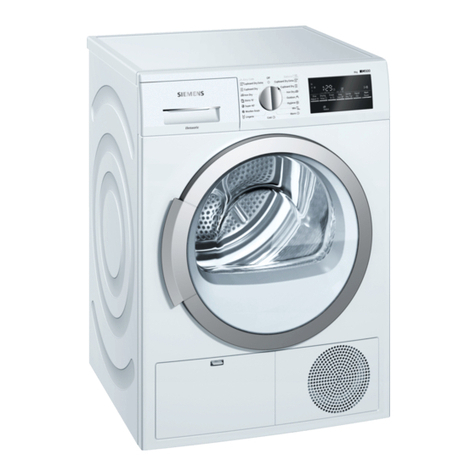
Siemens
Siemens WT46G401HK Assembly, installation and operation instructions
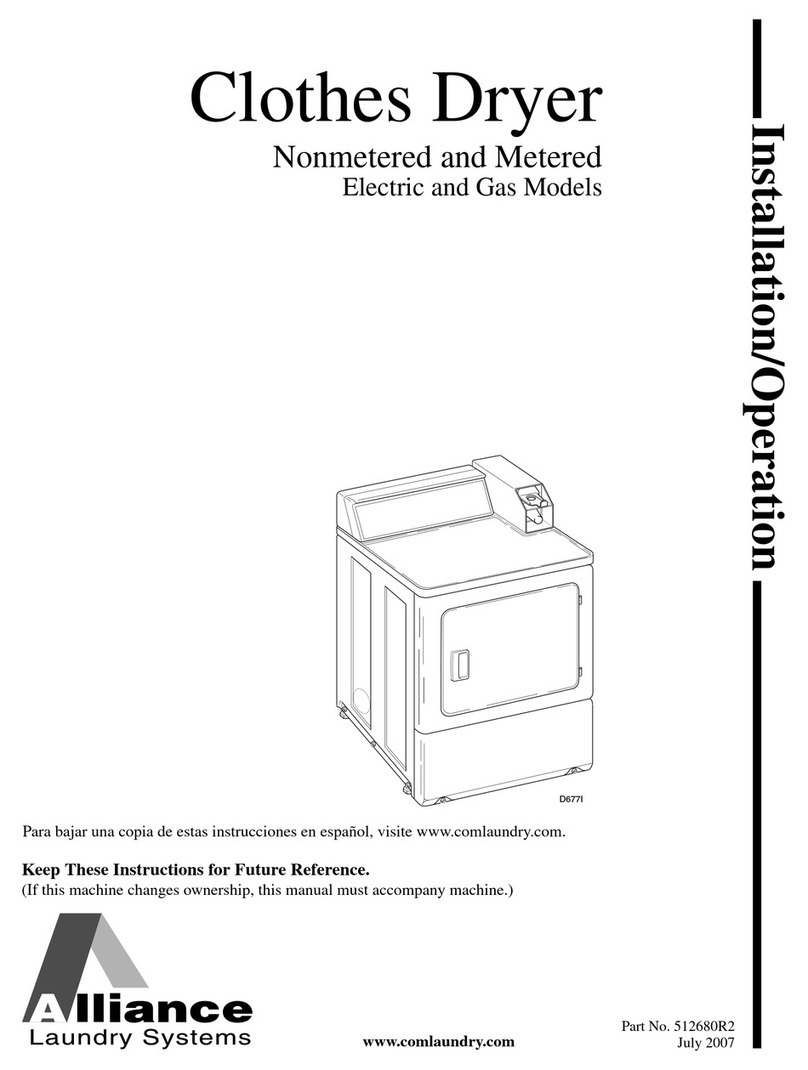
Alliance Laundry Systems
Alliance Laundry Systems continuity Installation and operation

LG
LG RV1865ESZ owner's manual

Hotpoint
Hotpoint FTCL 87 Instruction booklet

ROBINHOOD
ROBINHOOD RHSD7W Installation and operating instructions

Whirlpool
Whirlpool GCGM2991LQ0 Use and care guide
